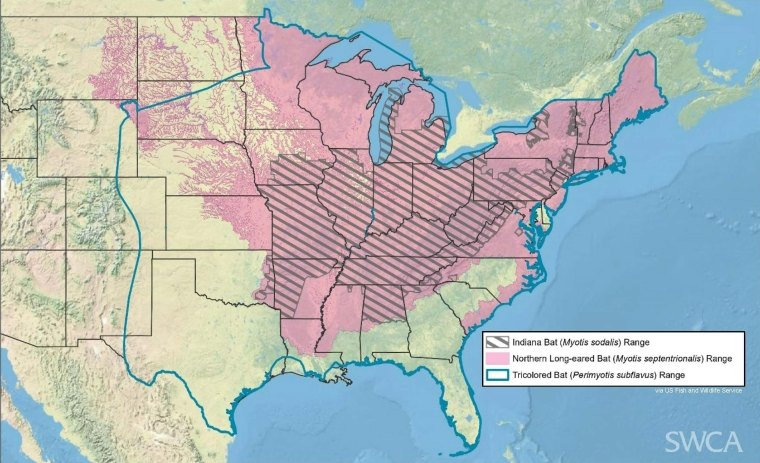As of March 31, 2023, the final rule to reclassify the northern long-eared bat (Myotis septentrionalis; NLEB) as endangered is in effect. The USFWS recently released several northern long-eared bat consultation tools for project proponents, summarized broadly as follows:
- 2023 Rangewide Indiana and Northern Long-eared Bat Survey Guidelines, including preliminary guidance on tricolored bat. The rangewide mist-netting level of survey effort is reduced from 2022 levels for both Indiana and northern long-eared bats; a longer survey window for NLEBs in their non-seasonal range (March 1 – November 15) is introduced, which is also applicable to tricolored bats in certain areas; and multiple, situation-dependent methods of analyses are specified
- Interim Consultation Framework: Projects with completion dates prior to April 1, 2024 that were previously in compliance with 4(d) rule can still use 4(d) rule. Designed to facilitate the transition from 4(d) to endangered. Includes a step-wise process for assessing NLEB risk
- Rangewide Determination Key: Set of structured questions available through IPaC. Can be used to achieve concurrence in certain situations; not applicable to all projects (e.g., wind development is excluded)
- Interim Wind Guidance and Technical Assistance Letter Template: Wind energy facilities are no longer exempt from incidental take of NLEB. Provides voluntary conservation measures for operation and monitoring at wind facilities (new or existing) in a manner where take is not reasonably expected to occur. Describes siting and curtailment strategies, and a recommendation for cut-in speeds during migration
- Interim Forestry Modification Guidance: Provides voluntary conservation measures to private forest landowners assessing risk to bats; outlines options to evaluate NLEB presence/absence, avoidance and minimization measures, and guidance on when to consult with the USFWS
- Updated Species Range Map: Large cut-outs in western portion of range, based on habitat modeling
These documents are available at: Northern Long-eared Bat (Myotis septentrionalis) | U.S. Fish & Wildlife Service (fws.gov).

SWCA CAN HELP
Please contact our bat experts to discuss what this new guidance might mean for your projects. Our robust field survey capability, bat technical expertise, and extensive regulatory compliance experience ensure we deliver Sound Science and Creative Solutions.
dcarson [at] swca [dot] com (subject: Regulatory%20Alert%3A%20Northern%20Long-eared%20Bat%20Final%20Rule) (Drew Carson) | Lead Project Manager
kmertz [at] swca [dot] com (subject: Regulatory%20Alert%3A%20Northern%20Long-eared%20Bat%20Final%20Rule) (Kely Wabnitz) | Senior Project Manager
Julia [dot] Wilson [at] swca [dot] com (subject: Regulatory%20Alert%3A%20Northern%20Long-eared%20Bat%20Final%20Rule) (Julia Wilson) | Bat Survey Manager, Associate Project Biologist